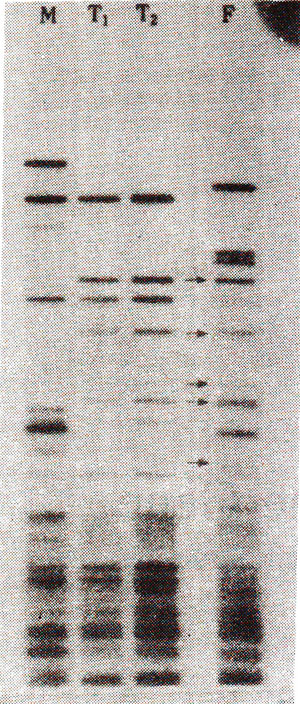
Fig. 24.9. DNA fingerprints, showing hypervariable sequences inherited by identical twins from their mother (M) and father (M). Arrows indicate bands common with father, but absent in mother (after A.J. Jeffreys, 1985).
The technique of DNA fingerprinting was developed for the first time (1985, 86) by
Alec Jeffreys and his colleagues at Leicester University in U.K. In this field, establishment of the identity of a person with the help of blood stains, semen (sperms) stains or hair roots will be possible with almost absolute certainty. In this technique, DNA will be isolated from blood stains, semen stains or hair roots and will be subjected to
Southern blotting and DNA hybridization with the help of specific DNA probes. This will reveal polymorphism in DNA, which has a very stable inheritance. For this purpose, DNA from blood, semen or urine stains may also be amplified using PCR technique (consult
Genetic Engineering and Biotechnology 1. Recombinant DNA and PCR (Cloning and Amplification of DNA)).
It is speculated that the above technique will allow the identification of rapists in rape cases, and of mother and or father in case of doubtful parentage (Fig. 24.9). This technique will allow identification even when the stains on victim's clothes etc. are several years old and with much more certainty than has hitherto been possible through techniques of blood groups etc., since the number of blood groups available becomes a limitation. The technique of
DNA fingerprinting reveals such a great polymorphism that the possibility of two persons having same pattern of DNA fingerprints is very remote.
In India,
DNA fingerprinting tests are carried out at the Centre for Cell and Molecular Biology (CCMB), Hyderabad. For this purpose, a test with the
Bkm probe (banded krait minor satellite DNA) earlier used for identification of sex chromosomes (consult
Sex Determination, Sex Differentiation, Dosage Compensation and Genetic Imprinting), has been found to cost one-tenth of the cost of tests used in Europe and U.S.A. Paternity dispute cases are much more common in India-and most of them are referred to
CCMB for DNA evidence. The first such test on DNA fingerprinting was used in June, 1989 to settle a drawn-out paternity case in Madras.

Fig. 24.9. DNA fingerprints, showing hypervariable sequences inherited by identical twins from their mother (M) and father (M). Arrows indicate bands common with father, but absent in mother (after A.J. Jeffreys, 1985).





